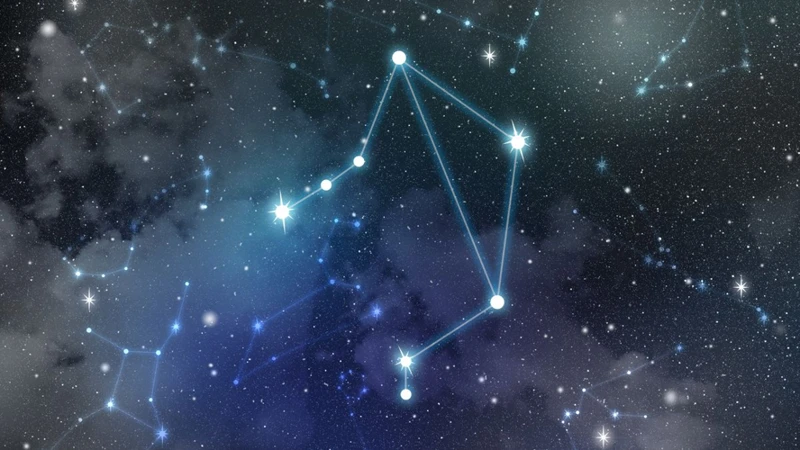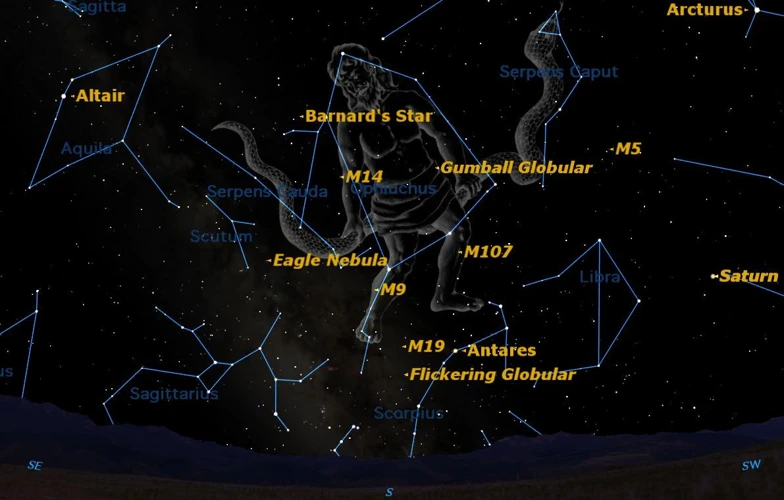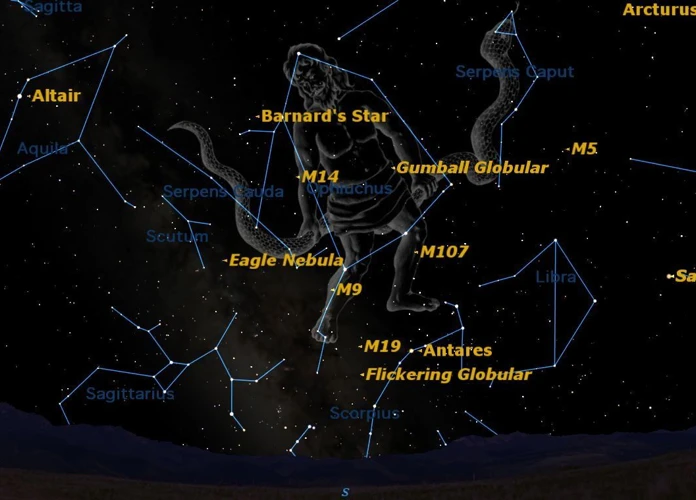Are there hidden secrets in the alignment of celestial objects? What role does Ophiuchus play in this cosmic puzzle? In this article, we will delve into the mysterious alignment of Ophiuchus with other celestial bodies and explore its mystical and scientific significance. From its connection to the zodiac constellations to the enigmatic gravitational effects it may have, Ophiuchus leaves astronomers and astrologers alike perplexed. Join us on this journey as we unlock the secrets of Ophiuchus and unravel the enigma that surrounds this celestial phenomenon.
Contents
- What is Ophiuchus?
- The Alignment of Ophiuchus
- The Mystical Significance
- Scientific Theories
- Exploring the Ophiuchus Enigma
- Conclusion
-
Frequently Asked Questions
- 1. Is Ophiuchus a new constellation?
- 2. Why is Ophiuchus not part of the zodiac?
- 3. What is the significance of Ophiuchus in Greek mythology?
- 4. How does Ophiuchus align with other zodiac constellations?
- 5. Does Ophiuchus have any astrological significance?
- 6. Are there any notable stars in the constellation of Ophiuchus?
- 7. Does Ophiuchus have any unusual effects on eclipses or the Earth’s atmosphere?
- 8. Are there any ancient myths or folklore that mention Ophiuchus?
- 9. What scientific theories explain the alignment of Ophiuchus?
- 10. Can the mysteries of Ophiuchus be fully explained?
- References
-
Frequently Asked Questions
- 1. Can Ophiuchus be seen with the naked eye?
- 2. Is Ophiuchus a part of the zodiac?
- 3. What is the significance of the alignment between Ophiuchus and Zodiac constellations?
- 4. Is there any scientific evidence supporting the alignment of Ophiuchus with other celestial objects?
- 5. What are the ancient mythological connections related to Ophiuchus?
- 6. How do astrologers interpret the presence of Ophiuchus in astrology?
- 7. Can the alignment of Ophiuchus with other celestial objects have gravitational effects?
- 8. Are there any known interactions between stars in Ophiuchus and neighboring constellations?
- 9. What are some theories surrounding the enigma of Ophiuchus?
- 10. How can we further explore and understand the mysteries surrounding Ophiuchus?
- References
- Read More
What is Ophiuchus?

Ophiuchus, also known as the Serpent Bearer, is a constellation located near the celestial equator. It lies between Aquila, Serpens, and Hercules, making it a fascinating part of the night sky. The name Ophiuchus is derived from Greek mythology, where it represents the healer Asclepius. In ancient times, Ophiuchus was considered to be a powerful figure associated with medicine and healing. This constellation is often depicted as a man grasping a serpent, symbolizing the mastery over life and death. Ophiuchus is the only constellation that is associated with a real person from history rather than a mythical creature. Its existence dates back to ancient times, with mentions of Ophiuchus found in Babylonian and Egyptian astronomical texts. Although not part of the traditional zodiac, Ophiuchus has gained attention in recent years due to its alignment with other celestial objects and its potential astrological significance. To learn more about the evolution of constellations over time, follow this link.
The Alignment of Ophiuchus

The alignment of Ophiuchus with other celestial objects is a fascinating phenomenon that continues to intrigue astronomers and astrologers. Ophiuchus forms unique connections with various celestial bodies, leading to speculation about its significance. One intriguing alignment is between Ophiuchus and the zodiac constellations. While not traditionally recognized as a zodiac sign, Ophiuchus intersects with the ecliptic – the path the Sun appears to take through the sky – and crosses paths with a portion of Scorpius, Sagittarius, and neighboring zodiac signs. This alignment raises questions about its potential astrological influence and whether it should be included as a thirteenth zodiac sign. Additionally, Ophiuchus aligns with other celestial events, such as eclipses, which reportedly produce unusual effects on Earth’s atmosphere. To explore the mystical creatures associated with Egyptian folklore, follow this link.
1. Ophiuchus and Zodiac Constellations
The relationship between Ophiuchus and the zodiac constellations is a subject of intrigue and debate. In the traditional zodiac system, there are twelve constellations that represent the astrological signs. However, Ophiuchus is often overlooked in this system. Positioned between Scorpio and Sagittarius, Ophiuchus cuts through the ecliptic, the apparent path of the Sun. This cosmic placement has led some to argue that Ophiuchus should be recognized as the thirteenth zodiac sign. Supporters of this idea believe that Ophiuchus’ alignment with the Sun during certain times of the year should be considered in astrological interpretations. This controversial topic has sparked discussions among astrologers, with some incorporating Ophiuchus into their readings and horoscopes. Scientists, on the other hand, view zodiac constellations as a human construct rather than having any influence on personality traits. To learn more about the unusual effects of eclipses on the Earth’s atmosphere, follow this link.
2. Ophiuchus and Galactic Alignment
Ophiuchus and Galactic Alignment
1. Galactic Center Alignment: One of the intriguing aspects of Ophiuchus is its alignment with the center of our Milky Way galaxy. The Milky Way is a spiral galaxy, and its center harbors a supermassive black hole known as Sagittarius A*. Ophiuchus lies near the direction of the galactic center, creating a captivating celestial alignment. This alignment has sparked curiosity among astronomers and stargazers alike, suggesting a cosmic connection between Ophiuchus and the heart of our galaxy.
2. Stellar Clusters and Nebulae: Ophiuchus is also known for its proximity to several stellar clusters and nebulae. One notable cluster is the Rho Ophiuchi Cluster, located in the constellation’s southern region. This cluster contains a diverse array of young stars, reflection nebulae, and dark nebulae. The nebulae within the Rho Ophiuchi complex are captivating and provide an awe-inspiring backdrop to Ophiuchus. Their alignment with this constellation enhances its mystique and visual allure.
3. Cosmic Equator: Another fascinating aspect of Ophiuchus is its alignment with the celestial equator. The celestial equator is an imaginary line projected onto the sky, directly above Earth’s equator. Ophiuchus straddles this celestial equator, symbolizing a connection between the Earth and the heavens. This alignment adds to Ophiuchus’ significance, as it bridges the gap between our human perspective and the vastness of the cosmos.
The alignment of Ophiuchus with the galactic center, stellar clusters, nebulae, and the celestial equator showcases its unique position in the night sky. Whether it is the cosmic connection to the Milky Way or its alignment with celestial features, Ophiuchus continues to captivate our imagination, inviting further exploration and contemplation.
The Mystical Significance

The mystical significance of Ophiuchus lies in its connection to ancient mythology and its interpretation in astrology. In ancient Greek mythology, Ophiuchus represents the healer Asclepius, often associated with the ability to cure diseases and bring about miraculous recoveries. This constellation holds a special place in Egyptian folklore as well, where it is believed to be associated with mythical creatures and powerful magical abilities. Astrologically, Ophiuchus has gained attention for its potential inclusion as the thirteenth zodiac sign, challenging the traditional twelve sign system. Some astrologers believe that those born under the sign of Ophiuchus possess unique qualities such as wisdom, intuition, and a deep understanding of the spiritual realm. The mystical significance of Ophiuchus continues to captivate and intrigue both astronomers and astrology enthusiasts alike. To learn more about the intricate world of astrological interpretations, follow this link.
1. Ancient Mythology and Ophiuchus
The ancient mythology surrounding Ophiuchus adds a layer of intrigue to this constellation. In Greek mythology, Ophiuchus represents the Greek god Asclepius, the son of Apollo and a renowned healer. According to the myth, Asclepius possessed great healing powers and was able to bring the dead back to life. This ability alarmed Hades, the god of the underworld, as it disrupted the natural order of life and death. In response, Zeus, the king of the gods, struck Asclepius down with a thunderbolt, turning him into a constellation to honor his contributions to medicine. In Egyptian folklore, Ophiuchus is associated with Imhotep, a legendary physician and architect who was deified after his death. Imhotep was highly revered for his medical and architectural skills, making him a revered figure in ancient Egypt. The connection between Ophiuchus and these prominent healers in mythology has further contributed to the enigmatic nature of this constellation. To learn more about the mythical creatures in Egyptian folklore, follow this link.
2. Astrological Interpretations
Astrological interpretations of Ophiuchus have sparked curiosity and debate among astrologers. While not traditionally included in the zodiac, Ophiuchus has gained attention as a potential thirteenth sign. Those who incorporate Ophiuchus into astrology believe that it brings a unique set of characteristics and traits. Astrologers suggest that individuals born under Ophiuchus are intuitive, wise, and have a healing nature. They are often seen as natural healers, having an innate ability to help and guide others. People associated with Ophiuchus are said to possess a deep understanding of the complexities of life, seeking truth and enlightenment. In astrological charts, Ophiuchus is believed to have influence over areas related to medicine, transformation, and spirituality. Astrologers also explore the influence of Ophiuchus on the other zodiac signs, considering how its alignment with other celestial bodies may impact individual horoscopes. While some embrace the addition of Ophiuchus in astrology, others remain skeptical, adhering to the traditional twelve zodiac signs. Regardless of the debates, the astrological interpretations of Ophiuchus continue to intrigue and captivate those delving into the mysteries of the stars.
Scientific Theories

Scientists have developed various theories to explain the mysterious alignment of Ophiuchus with other celestial objects. One intriguing scientific theory revolves around the gravitational effects that Ophiuchus may have on nearby stars and galaxies. It suggests that the gravitational pull of Ophiuchus may influence the motion and behavior of surrounding celestial bodies, creating a unique alignment. Another scientific theory focuses on the interactions between Ophiuchus and nearby stars. It proposes that the presence of Ophiuchus may lead to distinctive stellar interactions, resulting in the alignment of certain stars and galaxies. These scientific theories offer potential explanations for the enigmatic alignment of Ophiuchus, shedding light on the fascinating celestial phenomenon.
1. Gravitational Effects on Ophiuchus
1. Gravitational Effects on Ophiuchus:
The gravitational effects on Ophiuchus are a subject of much speculation and study among astronomers. The gravitational pull from nearby celestial bodies can have significant effects on the movement and dynamics of Ophiuchus. One interesting phenomenon associated with Ophiuchus is the gravitational lensing effect. This occurs when the gravitational field of a massive object, such as a galaxy or a black hole, bends the path of light passing through it. As a result, distant objects appear distorted or magnified when observed from certain angles. The gravitational lensing effect can provide valuable insights into the distribution and nature of dark matter, as well as help astronomers study distant galaxies and quasars.
Additionally, Ophiuchus is known to lie near the galactic plane, which is the flat disk-like structure containing most of the stars, gas, and dust in our Milky Way galaxy. This proximity to the galactic plane means that Ophiuchus is subject to the gravitational influences of neighboring stars and other galactic structures. These gravitational interactions can alter the dynamics of Ophiuchus and affect its alignment with other celestial objects.
Recent studies have suggested that Ophiuchus may play a role in the formation and evolution of stars and their planetary systems. The gravitational forces within Ophiuchus can trigger the collapse of molecular clouds, leading to the birth of new stars. The interaction between stars within Ophiuchus can also influence the formation and migration of planets in their respective systems.
The gravitational effects on Ophiuchus are multifaceted and have implications for various astronomical phenomena. From the gravitational lensing effect to its influence on star formation, Ophiuchus continues to captivate scientists and provide valuable insights into the workings of the universe.
2. Stellar Interactions and Ophiuchus
Stellar interactions and their connection to Ophiuchus have long captured the curiosity of astronomers. When it comes to this enigmatic constellation, there is a possibility that it may have intriguing interactions with neighboring stars and celestial objects. One fascinating aspect is the presence of binary or multiple star systems within Ophiuchus. These systems consist of two or more stars that orbit around a common center of mass, creating a captivating dance of cosmic forces. Stellar interactions within Ophiuchus can manifest in various ways, such as gravitational disturbances and even the exchange of matter between stars. These interactions can significantly influence the evolution and dynamics of the stars involved, shaping their trajectories and potentially leading to the formation of stellar clusters. The intricate interplay between stellar interactions and Ophiuchus raises numerous questions and avenues of research for astronomers to explore. By studying these stellar interactions, scientists hope to gain a deeper understanding of the evolution and formation of stars within this intriguing constellation.
Exploring the Ophiuchus Enigma

Exploring the Ophiuchus enigma leads us on a journey filled with intrigue and fascination. Scientists and researchers have been captivated by the alignment and interaction of Ophiuchus with other celestial objects. One aspect of this enigma is the unique position of Ophiuchus in relation to the zodiac constellations. While it is not officially recognized as one of the twelve zodiac signs, Ophiuchus lies along the ecliptic, the apparent path of the sun in the sky, intersecting with the other zodiac constellations. This alignment raises questions about the astrological implications and whether Ophiuchus should be included in the zodiac chart. Additionally, Ophiuchus is believed to have a significant galactic alignment. Its positioning in relation to the center of the Milky Way galaxy and other galactic features sparks curiosity about potential influences or connections with cosmic phenomena. The combination of Ophiuchus’ alignment with the zodiac constellations and its galactic significance contributes to the enigmatic nature of this celestial being. Unraveling the secrets of the Ophiuchus enigma continues to captivate the minds of astronomers and astrophysicists, shedding light on the intricate connections and cosmic forces that shape our understanding of the universe.
Conclusion

In conclusion, the alignment of Ophiuchus with other celestial objects presents a fascinating and perplexing cosmic phenomenon. From its connection to the zodiac constellations to its potential astrological interpretations, Ophiuchus has captured the curiosity of astronomers and astrologers alike. While ancient mythology provides insight into the significance of Ophiuchus as a healer and a symbol of power, scientific theories delve into the gravitational effects and stellar interactions that may be at play. The enigma surrounding Ophiuchus leaves us with more questions than answers, prompting further exploration and study. Whether we view it through the lens of ancient mythology or scientific exploration, Ophiuchus continues to inspire wonder and curiosity about the mysteries of the universe.
Frequently Asked Questions

1. Is Ophiuchus a new constellation?
No, Ophiuchus has been recognized as a constellation for centuries. Its existence dates back to ancient times and is mentioned in Babylonian and Egyptian astronomical texts.
2. Why is Ophiuchus not part of the zodiac?
The zodiac is divided into twelve equal parts, each representing a specific month of the year. Ophiuchus falls within the ecliptic, but it was not included in the traditional zodiac system followed by Western astrology.
3. What is the significance of Ophiuchus in Greek mythology?
In Greek mythology, Ophiuchus is associated with Asclepius, the god of medicine and healing. The constellation represents the healer who possessed the ability to resurrect the dead.
4. How does Ophiuchus align with other zodiac constellations?
Ophiuchus lies between Aquila, Serpens, and Hercules, creating a unique alignment with other zodiac constellations. Its position in the sky forms a connection between the celestial figures and their astrological associations.
5. Does Ophiuchus have any astrological significance?
Ophiuchus has gained attention in recent years as some astrologers explore its potential influence on personality traits and horoscopes. However, it is not widely recognized in mainstream astrology.
6. Are there any notable stars in the constellation of Ophiuchus?
Yes, Ophiuchus is home to several prominent stars, including Rasalhague (Alpha Ophiuchi), which is the brightest star in the constellation. Other notable stars include Sabik (Eta Ophiuchi) and Yed Prior (Delta Ophiuchi).
7. Does Ophiuchus have any unusual effects on eclipses or the Earth’s atmosphere?
There is no scientific evidence to suggest that Ophiuchus has any direct effects on eclipses or the Earth’s atmosphere. However, the alignment of celestial objects, including Ophiuchus, can create visually interesting phenomena during eclipses.
8. Are there any ancient myths or folklore that mention Ophiuchus?
Ophiuchus is mentioned in various mythologies and folklore. In Egyptian mythology, it is associated with the snake god known as Serqet. To learn more about Egyptian folklore and mythical creatures, follow this link.
9. What scientific theories explain the alignment of Ophiuchus?
Scientists have proposed theories such as gravitational effects and stellar interactions to explain the alignment of Ophiuchus with other celestial objects. These theories aim to understand the dynamics of the universe and the intricate relationships between different astronomical bodies.
10. Can the mysteries of Ophiuchus be fully explained?
While extensive research has been conducted on Ophiuchus, there is still much to discover and comprehend. The alignment of celestial objects and its significance continues to captivate scientists, astronomers, and astrologers, leaving some aspects of Ophiuchus shrouded in mystery.
References
Frequently Asked Questions

1. Can Ophiuchus be seen with the naked eye?
Yes, Ophiuchus is one of the 48 recognized constellations and can be seen in the night sky without the need for a telescope.
2. Is Ophiuchus a part of the zodiac?
Although Ophiuchus is not traditionally included in the zodiac, its path does cross the ecliptic, the apparent path of the Sun, Moon, and planets in the sky.
3. What is the significance of the alignment between Ophiuchus and Zodiac constellations?
The alignment between Ophiuchus and the Zodiac constellations is of interest because it challenges the traditional zodiac system and raises questions about the impact on astrology and horoscope predictions.
4. Is there any scientific evidence supporting the alignment of Ophiuchus with other celestial objects?
While the alignment of Ophiuchus with other celestial objects is a subject of study and speculation, scientific evidence regarding its specific influence is still being explored.
Ophiuchus is associated with various mythologies and often represents healers or individuals with great wisdom. It is linked to the Greek myth of Asclepius, the god of medicine.
6. How do astrologers interpret the presence of Ophiuchus in astrology?
Astrologers who recognize Ophiuchus interpret its presence as an additional zodiac sign that influences personality traits and astrological predictions, similar to the other recognized zodiac signs.
7. Can the alignment of Ophiuchus with other celestial objects have gravitational effects?
While the gravitational effects of Ophiuchus on other celestial objects are still a topic of scientific investigation, it is thought that any gravitational influence from Ophiuchus would likely be minimal due to its distance from other major celestial bodies.
8. Are there any known interactions between stars in Ophiuchus and neighboring constellations?
There are instances of stellar interactions between stars in Ophiuchus and neighboring constellations, but their significance in relation to the alignment of Ophiuchus with other celestial objects is still being studied.
9. What are some theories surrounding the enigma of Ophiuchus?
Theories range from the idea that Ophiuchus represents a missing 13th zodiac sign to suggestions of ancient knowledge and connections to extraterrestrial civilizations. However, concrete evidence for these theories is still lacking.
10. How can we further explore and understand the mysteries surrounding Ophiuchus?
Ongoing research, observations, and advancements in the fields of astronomy, astrology, and mythology will contribute to a better understanding of the mysteries surrounding Ophiuchus and its alignment with other celestial objects.







